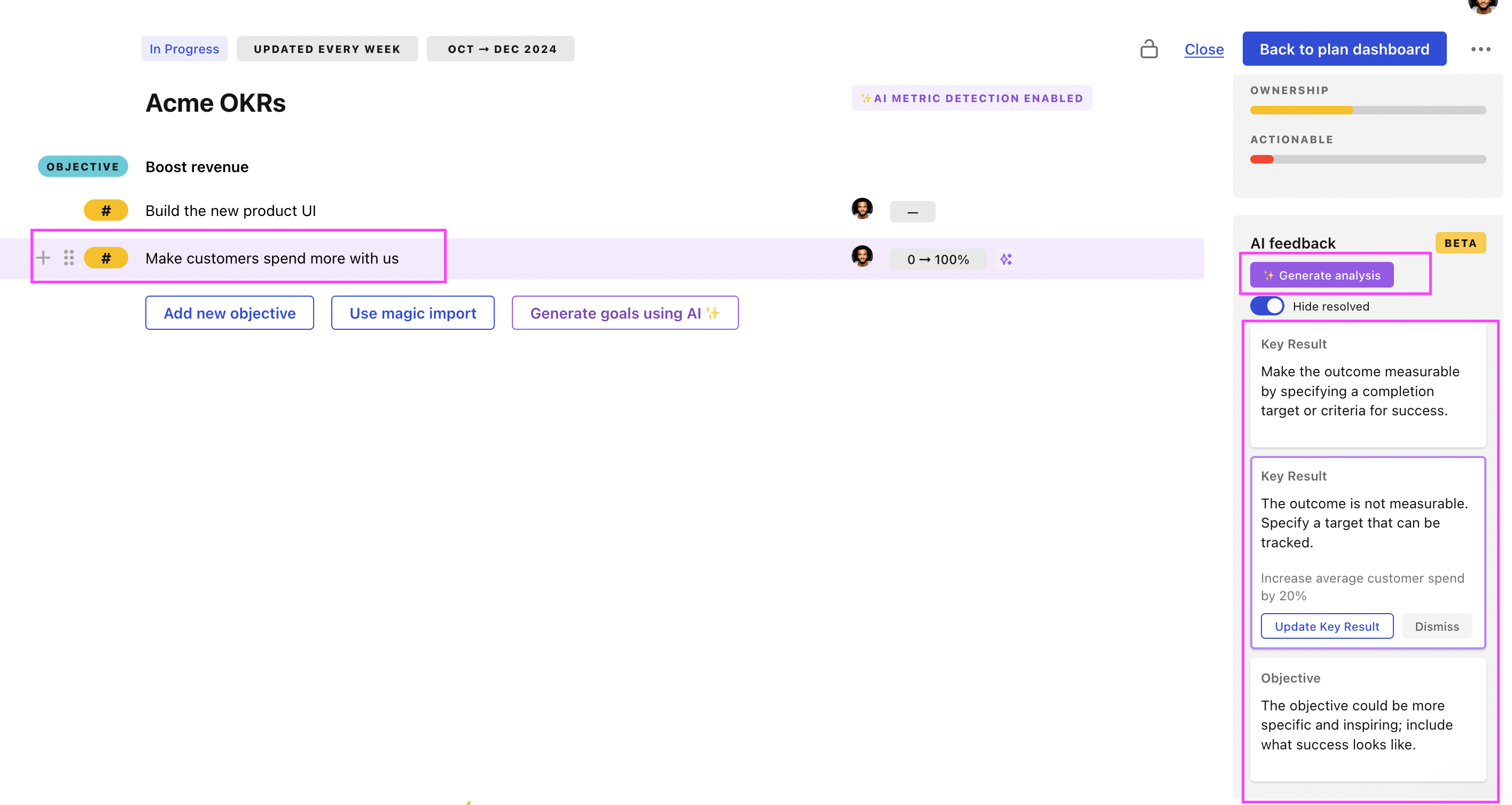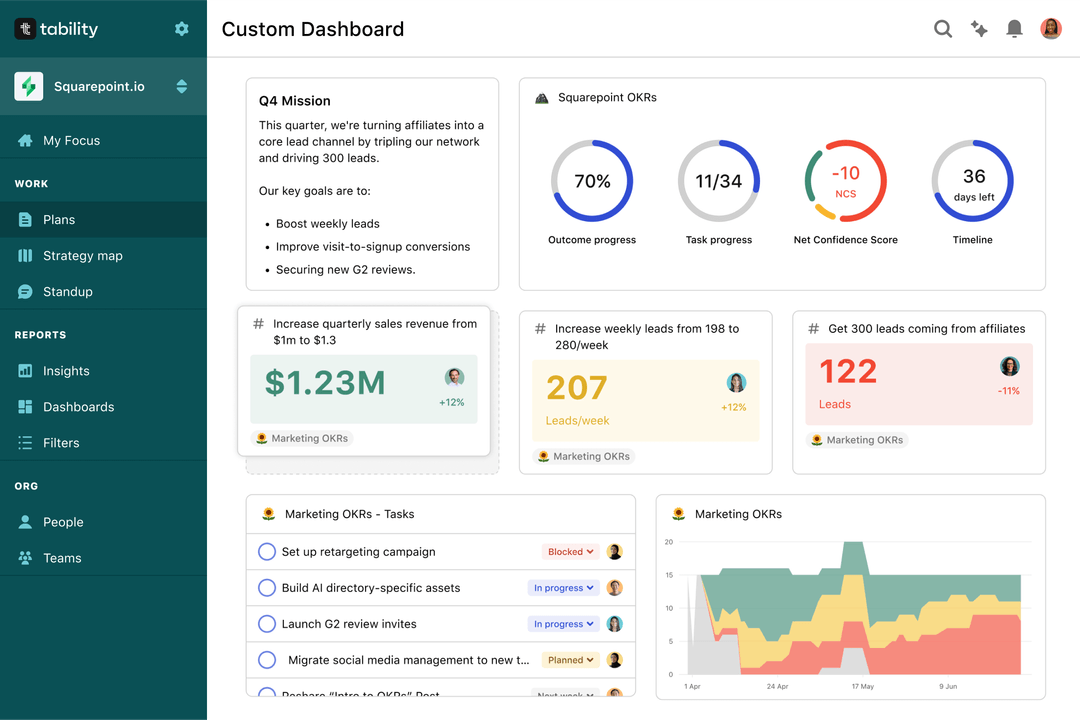Tability is a cheatcode for goal-driven teams. Set perfect OKRs with AI, stay focused on the work that matters.
What are Order Efficiency OKRs?
The Objective and Key Results (OKR) framework is a simple goal-setting methodology that was introduced at Intel by Andy Grove in the 70s. It became popular after John Doerr introduced it to Google in the 90s, and it's now used by teams of all sizes to set and track ambitious goals at scale.
Crafting effective OKRs can be challenging, particularly for beginners. Emphasizing outcomes rather than projects should be the core of your planning.
We've tailored a list of OKRs examples for Order Efficiency to help you. You can look at any of the templates below to get some inspiration for your own goals.
If you want to learn more about the framework, you can read our OKR guide online.
The best tools for writing perfect Order Efficiency OKRs
Here are 2 tools that can help you draft your OKRs in no time.
Tability AI: to generate OKRs based on a prompt
Tability AI allows you to describe your goals in a prompt, and generate a fully editable OKR template in seconds.
- 1. Create a Tability account
- 2. Click on the Generate goals using AI
- 3. Describe your goals in a prompt
- 4. Get your fully editable OKR template
- 5. Publish to start tracking progress and get automated OKR dashboards
Watch the video below to see it in action 👇
Tability Feedback: to improve existing OKRs
You can use Tability's AI feedback to improve your OKRs if you already have existing goals.
- 1. Create your Tability account
- 2. Add your existing OKRs (you can import them from a spreadsheet)
- 3. Click on Generate analysis
- 4. Review the suggestions and decide to accept or dismiss them
- 5. Publish to start tracking progress and get automated OKR dashboards

Tability will scan your OKRs and offer different suggestions to improve them. This can range from a small rewrite of a statement to make it clearer to a complete rewrite of the entire OKR.
Order Efficiency OKRs examples
You will find in the next section many different Order Efficiency Objectives and Key Results. We've included strategic initiatives in our templates to give you a better idea of the different between the key results (how we measure progress), and the initiatives (what we do to achieve the results).
Hope you'll find this helpful!
OKRs to streamline Order Entry Process
ObjectiveStreamline Order Entry Process
KRImplement automated order entry software to reduce manual errors by 30%
Train staff on new software use
Evaluate different automated order entry systems
Select and purchase suitable software
KRTrain 100% of order entry team to proficiently use the new system
Assess proficiency and address gaps in knowledge
Monitor staff progress and provide necessary support
Establish comprehensive training sessions on the new system
KRDecrease average order entry time by 25%
Monitor and streamline existing processes
Implement intuitive order-entry software
Train staff with efficient data-entry methods
OKRs to streamline upstream and downstream connections through improved order scheduling
ObjectiveStreamline upstream and downstream connections through improved order scheduling
KRIncrease the efficiency of order scheduling by 25% to enhance upstream connections
Update order scheduling software to newer version
Train staff on efficient scheduling practices
Implement real-time tracking for smoother order processing
KRReduce downstream connection errors by 30% through streamlined order processes
Standardize order entry to avoid mistakes
Implement efficient order tracking system
Develop robust process for order verification
KRAchieve 95% on-time order deliveries to optimize both upstream and downstream connections
Develop rigorous training for delivery personnel on punctuality
Establish regular audits of delivery timing and performance
Implement advanced route planning software for efficient delivery scheduling
OKRs to enhance warehouse OTIF performance
ObjectiveEnhance warehouse OTIF performance
KRBoost OTIF accuracy rate by 20% over the quarter
Provide staff training for efficient order fulfillment
Conduct regular OTIF accuracy audits
Implement a robust inventory management system
KRDecrease order processing errors by 15%
Train staff on meticulous order processing procedures
Implement a stringent double-checking system
Regularly update and refine order tracking software
KRImprove warehouse operation speed by 15%
Train staff on speedy and accurate order picking methods
Streamline receiving and shipping processes to reduce time waste
Implement advanced inventory management software for increased efficiency
OKRs to streamline inventory and filling systems for enhanced efficacy
ObjectiveStreamline inventory and filling systems for enhanced efficacy
KRReduce inventory holding costs by 15% via improved demand forecasting methods
Train employees in new forecasting methods
Implement improved demand forecasting software
Monitor and adjust inventory levels regularly
KRIncrease order fulfillment speed by 30% using an optimized filling system
Invest in high-speed order packaging and dispatch machinery
Implement a streamlined, efficient inventory management system
Train staff on optimized order fulfillment techniques
KRDecrease inventory errors by 25% through implementation of a new tracking system
Regularly review and analyze tracking accuracy
Train staff on new inventory tracking system use
Research and select an appropriate inventory tracking system
OKRs to streamline invoicing and purchasing processes
ObjectiveStreamline invoicing and purchasing processes
KRIncrease the on-time payment rate for invoices by 25%
Implement automated reminders for upcoming invoice due dates
Offer incentives for prompt payments
Simplify the payment process for customers
KRAchieve a 30% reduction in purchasing-related errors
Introduce stricter controls for purchase order approvals
Incorporate automated systems in the purchasing process
Implement regular training sessions on purchasing procedures
KRDecrease invoice processing time by 20%
Implement automated invoicing software
Train staff on efficient invoice procedures
Streamline invoice approval process
OKRs to improve efficiency in delivering book materials to students
ObjectiveImprove efficiency in delivering book materials to students
KRImplement a new book to student delivery system improving work-flow by 30%
Draft a blueprint of proposed new delivery system
Implement and test new delivery system
Research current book delivery methods and identify inefficiencies
KRReceive 90% positive feedback from students on the improved material delivery efficiency
Implement new material delivery system for easier access
Gather feedback after each lesson to assess changes
Make necessary improvements based on student suggestions
KRReduce delivery time of materials from books to students by 20%
Implement advanced logistical software for efficient dispatch and tracking
Build partnerships with reliable, faster delivery services
Streamline order processing and packaging procedures
Order Efficiency OKR best practices
Generally speaking, your objectives should be ambitious yet achievable, and your key results should be measurable and time-bound (using the SMART framework can be helpful). It is also recommended to list strategic initiatives under your key results, as it'll help you avoid the common mistake of listing projects in your KRs.
Here are a couple of best practices extracted from our OKR implementation guide 👇
Tip #1: Limit the number of key results
The #1 role of OKRs is to help you and your team focus on what really matters. Business-as-usual activities will still be happening, but you do not need to track your entire roadmap in the OKRs.
We recommend having 3-4 objectives, and 3-4 key results per objective. A platform like Tability can run audits on your data to help you identify the plans that have too many goals.
Tip #2: Commit to weekly OKR check-ins
Don't fall into the set-and-forget trap. It is important to adopt a weekly check-in process to get the full value of your OKRs and make your strategy agile – otherwise this is nothing more than a reporting exercise.
Being able to see trends for your key results will also keep yourself honest.
Tip #3: No more than 2 yellow statuses in a row
Yes, this is another tip for goal-tracking instead of goal-setting (but you'll get plenty of OKR examples above). But, once you have your goals defined, it will be your ability to keep the right sense of urgency that will make the difference.
As a rule of thumb, it's best to avoid having more than 2 yellow/at risk statuses in a row.
Make a call on the 3rd update. You should be either back on track, or off track. This sounds harsh but it's the best way to signal risks early enough to fix things.
Save hours with automated Order Efficiency OKR dashboards

OKRs without regular progress updates are just KPIs. You'll need to update progress on your OKRs every week to get the full benefits from the framework. Reviewing progress periodically has several advantages:
- It brings the goals back to the top of the mind
- It will highlight poorly set OKRs
- It will surface execution risks
- It improves transparency and accountability
We recommend using a spreadsheet for your first OKRs cycle. You'll need to get familiar with the scoring and tracking first. Then, you can scale your OKRs process by using Tability to save time with automated OKR dashboards, data connectors, and actionable insights.
How to get Tability dashboards:
- 1. Create a Tability account
- 2. Use the importers to add your OKRs (works with any spreadsheet or doc)
- 3. Publish your OKR plan
That's it! Tability will instantly get access to 10+ dashboards to monitor progress, visualise trends, and identify risks early.
More Order Efficiency OKR templates
We have more templates to help you draft your team goals and OKRs.
OKRs to enhance project management processes for improved success rate
OKRs to expand market reach by establishing partnerships with five new distributors or resellers
OKRs to successfully implement a robust talent management policy
OKRs to produce three engaging surgeon video testimonials
OKRs to produce and publish an engaging interactive book
OKRs to improve job prospects, personal relationships, and health this summer